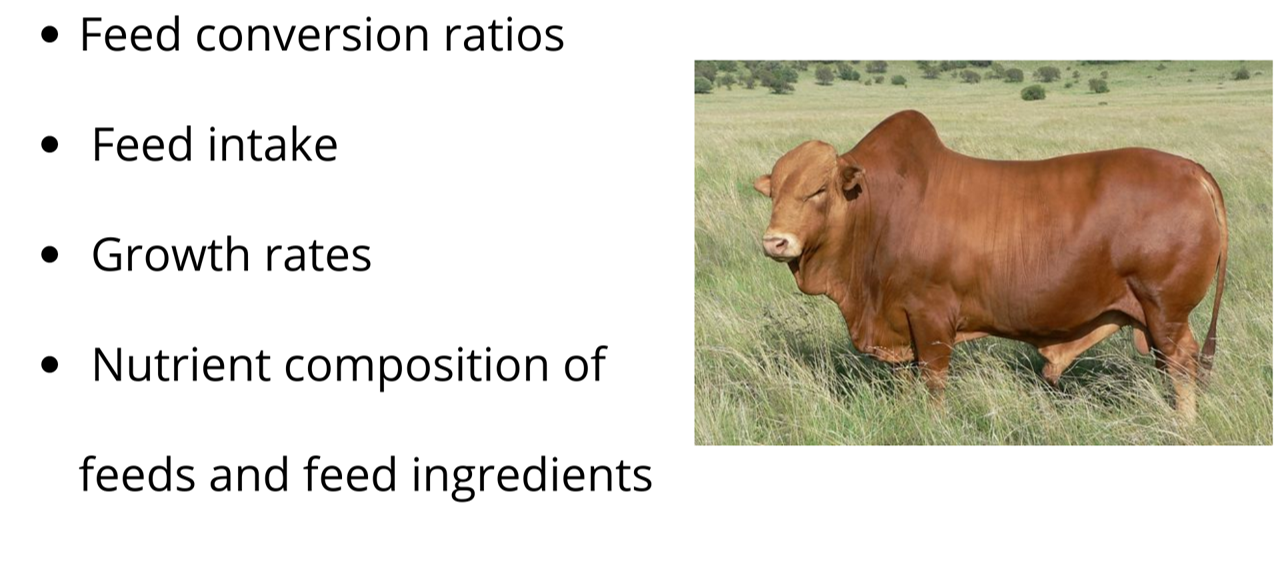
Feed Conversion Ratios
A feedlot steer may consume 15 kg of complete feed per day, whilst gaining 2.5 kg per day. The feed conversion ratio in this instance is thus 6.8. In other words, the steer consumes 6.8 kg of feed for every 1 kg of live weight gain. If this live weight gain is translated into carcass weight gain (one can assume a dressing percentage of 65%), then 1 kg of live weight gain translates into 650 g of carcass weight. Thus, for every 15 kg of feed consumed 1.625 kg of carcass is produced. Let us see whether this is a profitable situation.
Let us assume that the feed costs R1200 per ton. Thus, the feed costs for the feedlot steer is R18 per day (we are not including the other costs of the feedlot such as labour, electricity, water, etc). If the feedlot operator obtains R13.00 per kilogram live weight for his steer, the Rand per kilogram carcass weight translates into R20. The feedlot operator can expect to make R2 per kilogram of carcass weight gained by the steer. It is thus important that the feedlot operator tries and obtains an optimal weight gain for the least amount of feed. He cannot starve his animals (this would result in little weight gain) so he must ensure that the feed conversion ratio is as low as possible. For example, a chicken has a feed conversion ratio of approximately 2! This means that the chicken consumes 2 kg of feed for every 1 kg of weight gained. Imagine the fantastic future feeds necessary if a feed conversion ratio of 2 could be obtained for feedlot steers
Feed Intake
Even when animals are fed in groups, estimates of feed intake per animal can still be made. This is done by measuring the amount of feed provided to the group, measuring the amount of feed left over by the group, and dividing the amount consumed by the number of animals in the group. If animals are grouped according to similar sizes and types, then an assumption can be made that feed consumption of individuals within the group are roughly the same.
Several methods can be used to stimulate intake of feed. Such methods include pelleting of the ration (which reduces selection), adding palatable substances such as molasses, reducing the stressors in the environment of the animal (for example removing animals that bully, allowing enough crib space, ensuring the health of the animal) and reducing the dustiness of the feed.
Growth Rates
If regular weighing is done and all animal weights recorded it is possible to determine whether there is a problem in the herd. For example, if your animals are grazing on pasture with a feed supplement provided, and excellent weight gains are obtained in the month of November, but poorer weight gains are obtained in the month of December, this may be an indication that the grazing quality is reducing, and an adjustment must be made to the feed supplement. Or, it may be an indication that the animals are experiencing an increased parasite load (e.g. tape worm), and that they should be treated with anthelminthic.
Nutrient Composition of Feeds and Feed Ingredients
If feed ingredients grown on the farm are analysed on a regular basis (monthly), then it is possible to adjust the feed supplementation required (if any is required) to match the nutrients already provided by the grazing. This manner of feed management will provide the farmer with the best growth rates since he/she is not overfeeding or underfeeding the herd. This is also a good method to manage the costs of feed supplementation since supplementation will only be done when absolutely necessary.